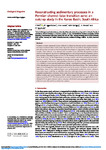Reconstructing sedimentary processes in a Permian channel–lobe transition zone: an outcrop study in the Karoo Basin, South Africa
| dc.contributor.author | Pohl, Florian | |
| dc.contributor.author | Eggenhuisen, JT | |
| dc.contributor.author | de Leeuw, J | |
| dc.contributor.author | Cartigny, MJB | |
| dc.contributor.author | Brooks, HL | |
| dc.contributor.author | Spychala, YT | |
| dc.date.accessioned | 2022-10-24T14:56:38Z | |
| dc.date.available | 2022-10-24T14:56:38Z | |
| dc.date.issued | 2022-09-29 | |
| dc.identifier.issn | 1469-5081 | |
| dc.identifier.issn | 1469-5081 | |
| dc.identifier.other | PII S0016756822000693 | |
| dc.identifier.uri | http://hdl.handle.net/10026.1/19748 | |
| dc.description.abstract |
<jats:title>Abstract</jats:title> <jats:p>Turbidity currents commonly bypass sediment in submarine channels on the continental slope, and deposit sediment lobes farther down-dip on the flat and unconfined abyssal plain. Seafloor and outcrop data have shown that the transition from bypass to deposition usually occurs over complex zones referred to as channel–lobe transition zones (CLTZs). Recognition of these zones in cores and outcrop remains challenging due to a lack of characteristic sedimentary facies and structures. This paper focuses on Unit E of the Permian Fort Brown Formation in the Karoo Basin, South Africa, in the Slagtersfontein outcrop complex, which has previously been interpreted as a CLTZ. This study integrates thin-section micrographs, sedimentary facies, bed-set and stratigraphic architecture, and palaeoflow directions to achieve a multiscale analysis of CLTZ features. A novel process-based facies scheme is developed to evaluate deposits in terms of the depositional or erosional tendencies of the flows that formed them. This scheme allows bypass to be distinguished from depositional zones by the spatial distribution of certain sediment facies. Areas of net sediment bypass were predominantly marked by erosive sediment facies and a larger variability in palaeoflow direction while depositional areas showed a lower variability in palaeoflow directions. Metre-scale structures in the bypass-dominated area reveal seafloor erosion and scour formation. Field relations suggest the presence of a ∼500 m long mega-scour in the CLTZ. The characteristic structures documented here are applicable for identifying CLTZs in sparse datasets such as outcrops with limited palaeogeographical context and sediment cores obtained from subsurface systems.</jats:p> | |
| dc.format.extent | 107-126 | |
| dc.language | en | |
| dc.language.iso | en | |
| dc.publisher | Cambridge University Press | |
| dc.subject | turbidity current | |
| dc.subject | deep marine | |
| dc.subject | sediment bypass | |
| dc.subject | sediment facies | |
| dc.subject | scour fields | |
| dc.title | Reconstructing sedimentary processes in a Permian channel–lobe transition zone: an outcrop study in the Karoo Basin, South Africa | |
| dc.type | journal-article | |
| plymouth.author-url | https://www.webofscience.com/api/gateway?GWVersion=2&SrcApp=PARTNER_APP&SrcAuth=LinksAMR&KeyUT=WOS:000861632100001&DestLinkType=FullRecord&DestApp=ALL_WOS&UsrCustomerID=11bb513d99f797142bcfeffcc58ea008 | |
| plymouth.issue | 1 | |
| plymouth.volume | 160 | |
| plymouth.publication-status | Published | |
| plymouth.journal | Geological Magazine | |
| dc.identifier.doi | 10.1017/s0016756822000693 | |
| plymouth.organisational-group | /Plymouth | |
| plymouth.organisational-group | /Plymouth/Faculty of Science and Engineering | |
| plymouth.organisational-group | /Plymouth/Faculty of Science and Engineering/School of Biological and Marine Sciences | |
| plymouth.organisational-group | /Plymouth/Users by role | |
| plymouth.organisational-group | /Plymouth/Users by role/Academics | |
| dcterms.dateAccepted | 2022-06-20 | |
| dc.rights.embargodate | 2022-10-25 | |
| dc.identifier.eissn | 1469-5081 | |
| dc.rights.embargoperiod | Not known | |
| rioxxterms.versionofrecord | 10.1017/s0016756822000693 | |
| rioxxterms.licenseref.uri | http://www.rioxx.net/licenses/all-rights-reserved | |
| rioxxterms.type | Journal Article/Review |


